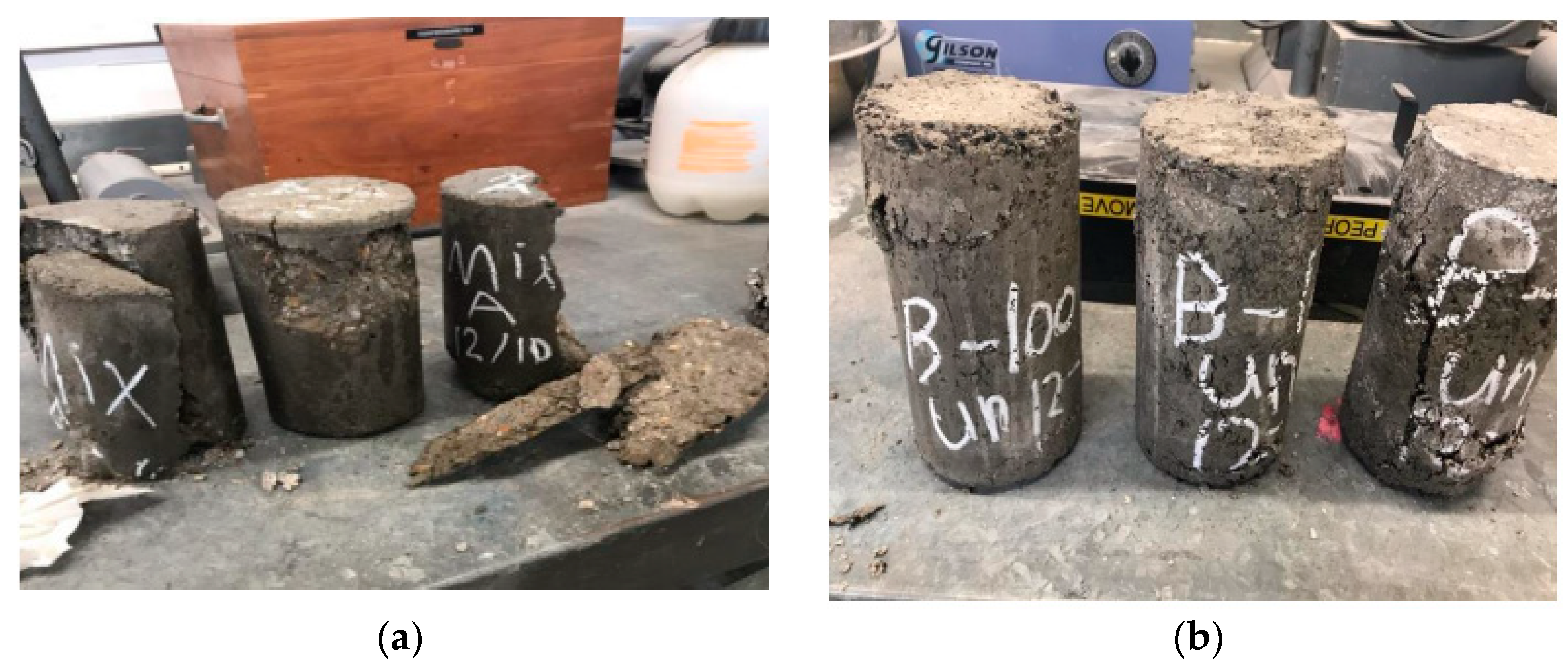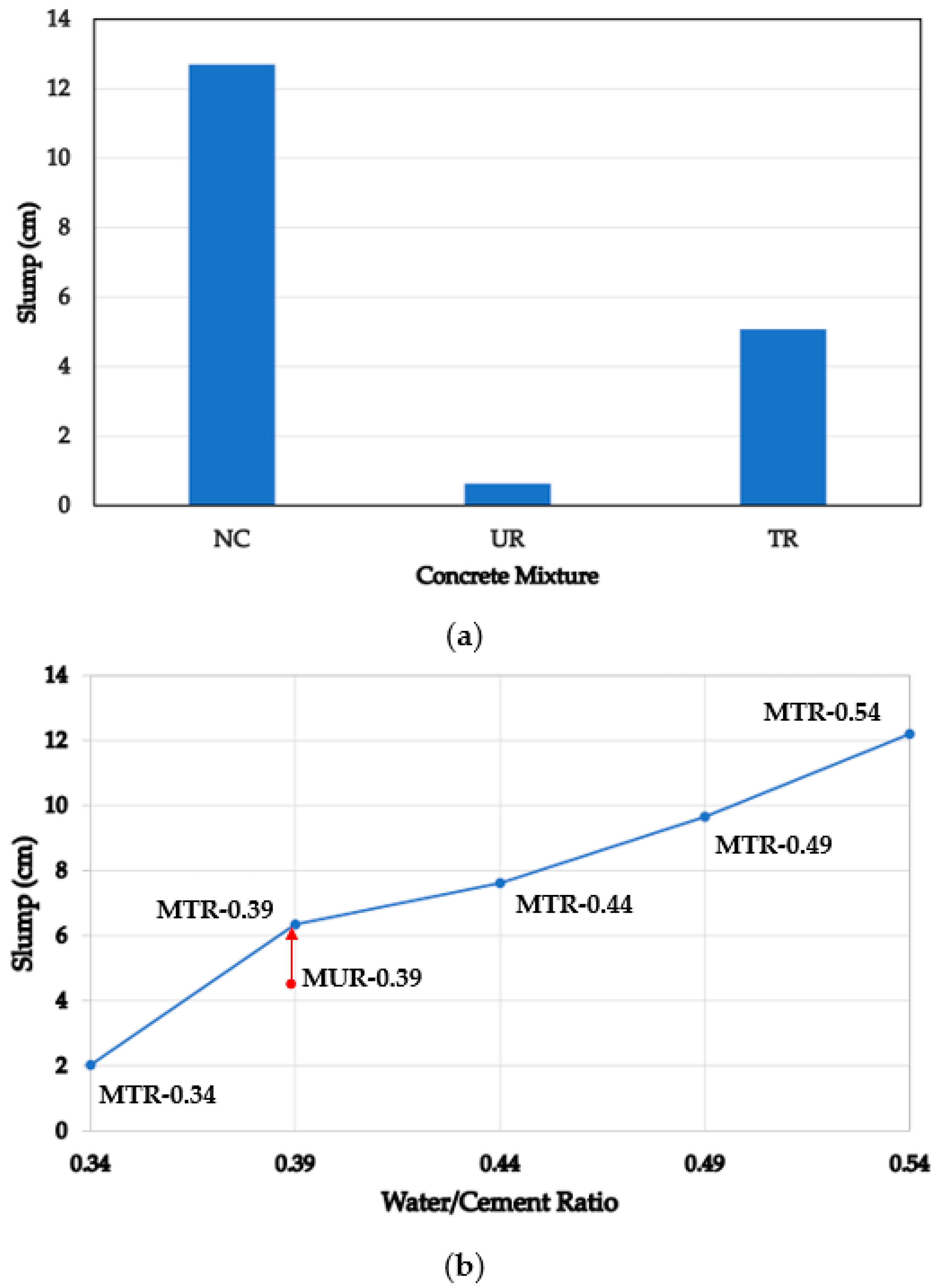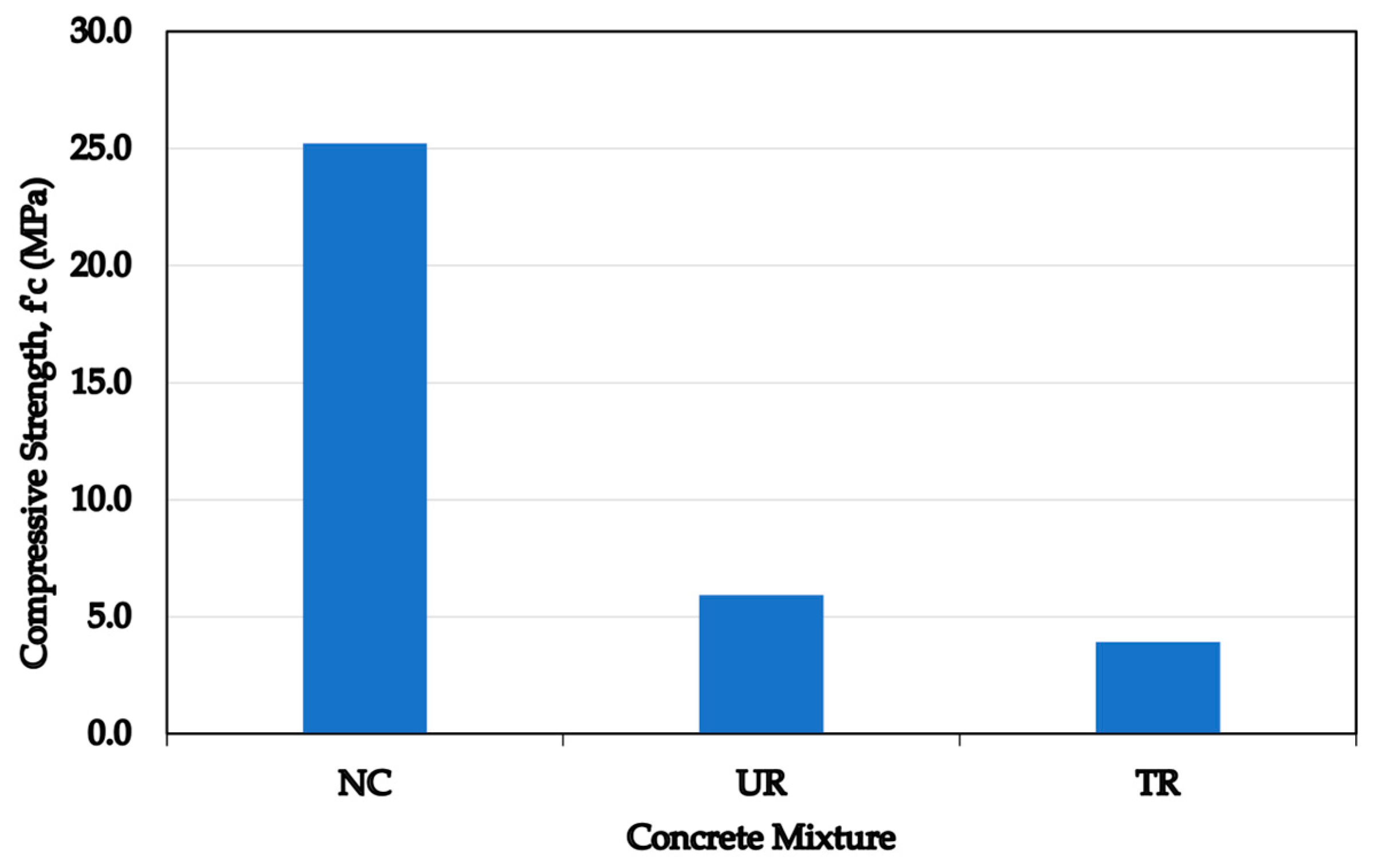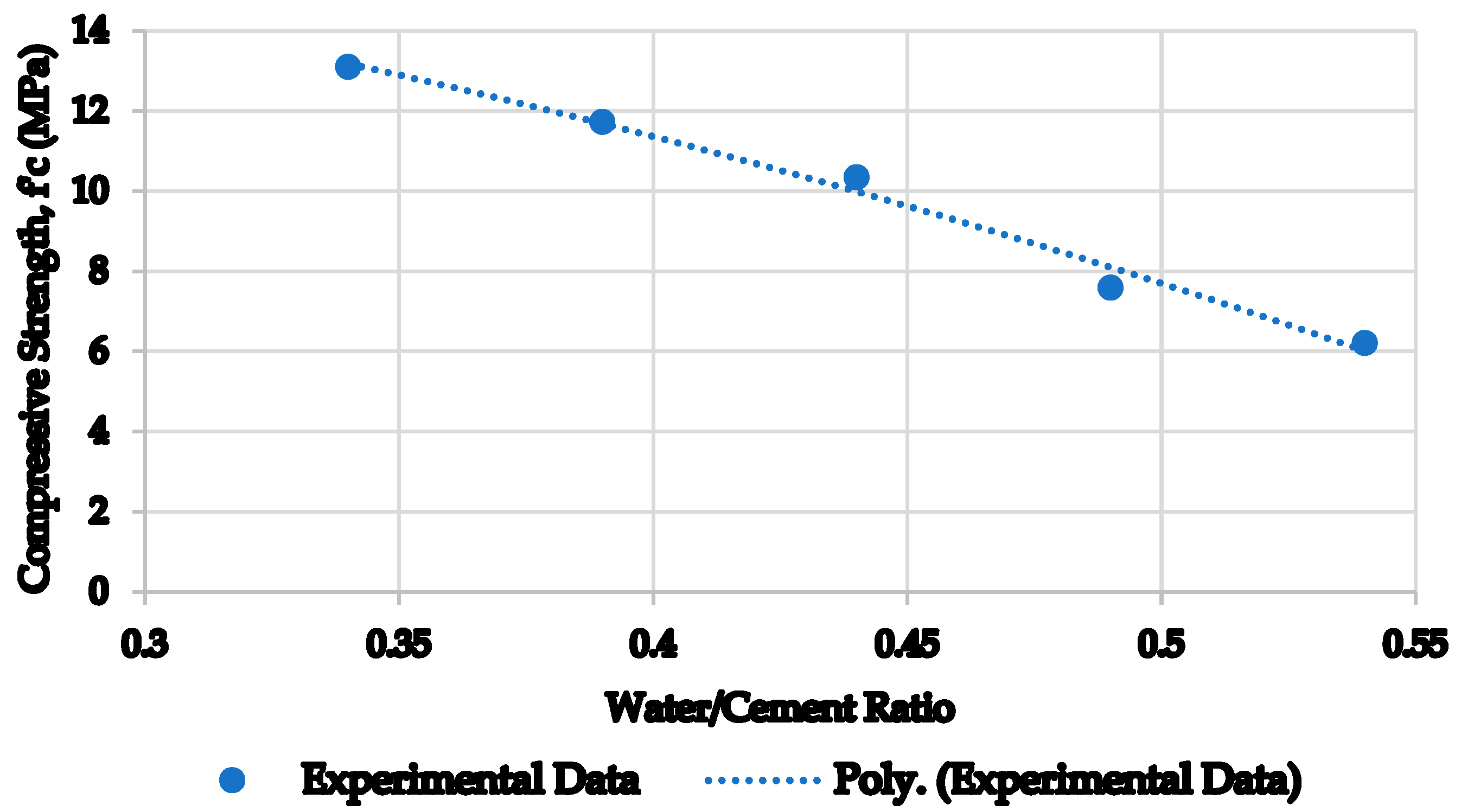Optimizing Sustainability of Concrete Structures Using Tire-Derived Aggregates: A Performance Improvement Study
Abstract
:1. Introduction
2. Experimental Program—Test Matrix and Procedure
2.1. Concrete Mix
2.1.1. Raw Materials
2.1.2. Mix Design
2.2. Materials Testing
3. Test Results and Discussions
3.1. Workability of Concrete
3.2. Compressive Strength Test
4. Conclusions
- The chemical pretreatment of TDA using NaOH solution significantly enhances the workability of rubberized concrete compared to using untreated TDA. Incorporating NaOH-treated TDA results in a 4.45 cm (1.75 in) increase in slump at the same water–cement ratio compared to untreated specimens;
- The pretreatment of rubber with NaOH leads to a reduction of approximately 34% in the compressive strength of TR-concrete mixture compared to UR-mixture at the same water–cement ratio. While NaOH pretreatment improves workability, it is not sufficient to enhance the compressive strength of rubberized concrete;
- Modified-TDA concrete shows an enhanced performance when treated with a combination of NaOH and SikaLatex bonding agent. This treatment leads to improved workability and compressive strength in both MTR-mixtures and MUR-mixtures. However, it is worth noting that MUR-mixture exhibits a lower compressive strength compared to MTR-mixture;
- The experimental results of the test specimens demonstrate the positive effect of NaOH pretreatment on the strength of rubberized concrete when used in conjunction with other treatment methods, such as the addition of a bonding agent;
- The decline in the compressive strength of rubberized concrete is more pronounced with an increase in the water–cement ratio. It is recommended to design modified-TDA concrete with a water–cement ratio below 0.34, while incorporating superplasticizer for optimal performance;
- An empirical equation is developed in this paper to predict the compressive strength of modified-TDA concrete based on its water–cement ratio.
Author Contributions
Funding
Data Availability Statement
Acknowledgments
Conflicts of Interest
References
- Geosyntec. Guidance Manual for Engineering Uses of Scrap Tires: Geosyntec Project no. ME0012-11; Maryland Department of the Environment: Baltimore, MD, USA, 2008. [Google Scholar]
- Kazmi, S.M.S.; Munir, M.J.; Wu, Y.F. Application of waste tire rubber and recycled aggregates in concrete products: A new compression casting approach. Resour. Conserv. Recycl. 2021, 167, 105353. [Google Scholar] [CrossRef]
- Thomas, B.S.; Gupta, R.C. A comprehensive review on the applications of waste tire rubber in cement concrete. Renew. Sustain. Energy Rev. 2016, 54, 1323–1333. [Google Scholar] [CrossRef]
- Ganjian, E.; Khorami, M.; Maghsoudi, A.A. Scrap-tyre-rubber replacement for aggregate and filler in concrete. Constr. Build. Mater. 2009, 23, 1828–1836. [Google Scholar] [CrossRef]
- Mohammadi, I.; Khabbaz, H.; Vessalas, K. Enhancing mechanical performance of rubberized concrete pavements with sodium hydroxide treatment. Mater. Struct. 2015, 49, 813–827. [Google Scholar] [CrossRef]
- Siddique, R.; Naik, T.R. Properties of concrete containing scrap-tire rubber--an overview. Waste Manag. 2004, 24, 563–569. [Google Scholar] [CrossRef] [PubMed]
- Nazari, M.; Tehrani, F.M.; Ansari, M. Lightweight Rubberized Concrete Slabs for Sustainable Road Pavements Serving Non-Auto Traffic. Period. Polytech. Civ. Eng. 2022, 66, 460–470. [Google Scholar] [CrossRef]
- Bai, G.; Zhu, C.; Liu, C.; Liu, B. An evaluation of the recycled aggregate characteristics and the recycled aggregate concrete mechanical properties. Constr. Build. Mater. 2020, 240, 117978. [Google Scholar] [CrossRef]
- Siringi, G.; Abolmaali, A.; Aswath, P.B. Properties of Concrete with Tire Derived Aggregate Partially Replacing Coarse Aggregates. Sci. World J. 2015, 2015, 863706. [Google Scholar] [CrossRef] [PubMed]
- Li, G.; Garrick, G.; Eggers, J.; Abadie, C.; Stubblefield, M.A.; Pang, S.S. Waste tire fiber modified concrete. Compos. Part B Eng. 2004, 35, 305–312. [Google Scholar] [CrossRef]
- Tian, S.; Zhang, T.; Li, Y. Research on Modifier and Modified Process for Rubber-Particle Used in Rubberized Concrete for Road. Adv. Mater. Res. 2011, 243–249, 4125–4130. [Google Scholar] [CrossRef]
- Miller, N.M.; Tehrani, F.M. Mechanical properties of rubberized lightweight aggregate concrete. Constr. Build. Mater. 2017, 147, 264–271. [Google Scholar] [CrossRef]
- ACI 211.1-91; Standard Practice for Selecting Proportions for Normal, Heavyweight, and Mass Concrete. ACI (American Concrete Institute): Farmington Hills, MI, USA, 1996.
- ASTM C33/C33M; Standard Specification for Concrete Aggregates. ASTM International: West Conshohocken, PA, USA, 2023.
- Su, H.; Yang, J.; Ling, T.C.; Ghataora, G.S.; Dirar, S. Properties of concrete prepared with waste tyre rubber particles of uniform and varying sizes. J. Clean. Prod. 2015, 91, 288–296. [Google Scholar] [CrossRef]
- Weng, T.L.; Lin, W.T.; Cheng, A. Effect of metakaolin on strength and efflorescence quantity of cement-based composites. Sci. World J. 2013, 2013, 606524. [Google Scholar] [CrossRef] [PubMed]
- ASTM C143; Standard Test Method for Slump of Hydraulic-Cement Concrete. ASTM (American Society for Testing and Materials) International: West Conshohocken, PA, USA, 2015.
- ASTM C39/C39M; Standard Test Method for Compressive Strength of Cylindrical Concrete Specimens. ASTM International: West Conshohocken, PA, USA, 2021.
- Khorrami, M.; Vafai, A.; Khalilitabas, A.A.; Desai, C.S.; Ardakani, M.H.M. Experimental Investigation on Mechanical Characteristics and Environmental Effects on Rubber Concrete. Int. J. Concr. Struct. Mater. 2010, 4, 17–23. [Google Scholar] [CrossRef]








| Batch Number | Batch Identification | Water-Cement Ratio | Compressive Strength, MPa (psi) | |
|---|---|---|---|---|
| First Group | 1 | NC 1 | 0.68 | 13.8 (2000) |
| 2 | UR 2 | 0.68 | 13.8 (2000) | |
| 3 | TR 3 | 0.68 | 13.8 (2000) | |
| Second Group | 4 | MTR-0.34 | 0.34 | 39.1 (5675) |
| 5 | MTR-0.39 4 | 0.39 | 34.5 (5000) | |
| 6 | MUR-0.39 5 | 0.39 | 34.5 (5000) | |
| 7 | MTR-0.44 | 0.44 | 29.2 (4229) | |
| 8 | MTR-0.49 | 0.49 | 25.4 (3689) | |
| 9 | MTR-0.54 | 0.54 | 23.9 (3467) | |
| Component | Batch Number | ||||||||
|---|---|---|---|---|---|---|---|---|---|
| 1 | 2 | 3 | 4 | 5 | 6 | 7 | 8 | 9 | |
| Cement, kg (lb) | 334.8 (20.9) | 283.5 (17.7) | 283.5 (17.7) | 568.7 (35.5) | 495 (30.9) | 495 (30.9) | 438.9 (27.4) | 394.1 (24.6) | 357.2 (22.3) |
| Water, kg (lb) | 169.8 (10.6) | 181 (11.3) | 181 (11.3) | 193.8 (12.1) | 189 (11.8) | 189 (11.8) | 185.8 (11.6) | 182.6 (11.4) | 181 (11.3) |
| Gravel, kg (lb) | 733.6 (45.8) | 0 | 0 | 0 | 0 | 0 | 0 | 0 | 0 |
| TDA, kg (lb) | 0 | 309.2 (19.3) | 309.2 (19.3) | 309.2 (19.3) | 309.2 (19.3) | 309.2 (19.3 | 309.2 (19.3) | 309.2 (19.3) | 309.2 (19.3) |
| Sand, kg (lb) | 1023.6 (63.9) | 1006 (62.8) | 1006 (62.8) | 693.6 (43.3) | 775.3 (48.4) | 775.3 (48.4) | 837.8 (52.3) | 887.4 (55.4) | 929.1 (58.0) |
| SikaLatex, kg (lb) | 0 | 0 | 0 | 28.8 (1.8) | 28.8 (1.8) | 28.8 (1.8) | 28.8 (1.8) | 28.8 (1.8) | 28.8 (1.8) |
| Plasticizer, kg (lb) | 0 | 0 | 0 | 3.2 (0.2) | 1.6 (0.1) | 1.6 (0.1) | 1.6 (0.1) | 1.6 (0.1) | 1.6 (0.1) |
| Metakaolin, kg (lb) | 0 | 51.3 (3.2) | 51.3 (3.2) | 104.1 (6.5) | 89.7 (5.6) | 89.7 (5.6) | 80.1 (5.0) | 72.1 (4.5) | 65.7 (4.1) |
Disclaimer/Publisher’s Note: The statements, opinions and data contained in all publications are solely those of the individual author(s) and contributor(s) and not of MDPI and/or the editor(s). MDPI and/or the editor(s) disclaim responsibility for any injury to people or property resulting from any ideas, methods, instructions or products referred to in the content. |
© 2023 by the authors. Licensee MDPI, Basel, Switzerland. This article is an open access article distributed under the terms and conditions of the Creative Commons Attribution (CC BY) license (https://creativecommons.org/licenses/by/4.0/).
Share and Cite
Younis, Z.A.; Nazari, M. Optimizing Sustainability of Concrete Structures Using Tire-Derived Aggregates: A Performance Improvement Study. CivilEng 2024, 5, 30-40. https://doi.org/10.3390/civileng5010002
Younis ZA, Nazari M. Optimizing Sustainability of Concrete Structures Using Tire-Derived Aggregates: A Performance Improvement Study. CivilEng. 2024; 5(1):30-40. https://doi.org/10.3390/civileng5010002
Chicago/Turabian StyleYounis, Zeinab A., and Maryam Nazari. 2024. "Optimizing Sustainability of Concrete Structures Using Tire-Derived Aggregates: A Performance Improvement Study" CivilEng 5, no. 1: 30-40. https://doi.org/10.3390/civileng5010002






